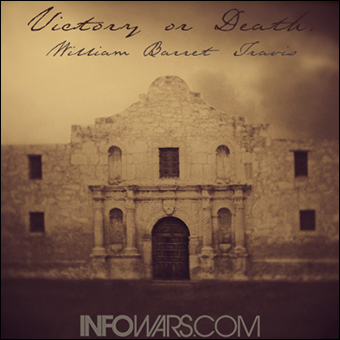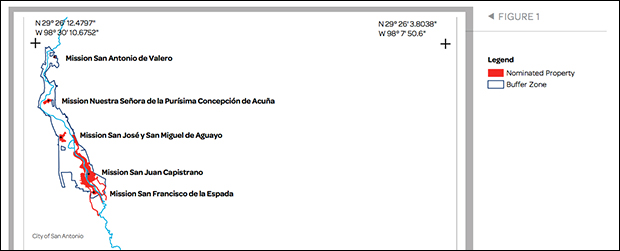Kit Daniels
Infowars.com
October 31, 2013
UPDATE: According to UNESCO’s 2013 Operational Guidelines for the Implementation of the World Heritage Convention, “potential danger” within the proposed 4,500+ acre “buffer zone” around the Alamo, including the “threat of armed conflict,” would jeopardize the mission’s “World Heritage” status, meaning that the City of San Antonio will likely use U.N. guidelines to ban future Second Amendment rallies near the Alamo, such as the successful Oct. 19 Come and Take It San Antonio rally which Texas Land Commissioner Jerry Patterson helped organize.
In its official statement regarding the United Nations takeover of the Alamo, the Texas General Land Office did not address the restrictions that will be placed on private property surrounding the Alamo once it is named a UN Educational, Scientific and Cultural Organization (UNESCO) World Heritage Site, even though the official nomination makes it clear that thousands of property owners will be affected.

The GLO’s press release published yesterday never mentioned the loss of property rights in the proposed 4,500+ acre “buffer zone” surrounding the Alamo, which places “complementary legal and/or customary restrictions” on private property within the vicinity of UNESCO World Heritage Sites.
“Some folks might think that getting on this [UNESCO World Heritage] list means the U.N. has some sort of influence at the Alamo,” Texas Land Commissioner Jerry Patterson said.
Those “folks” are correct according to the official Nomination for Inscription on the World Heritage List and UNESCO’s very own Operational Guidelines for the Implementation of the World Heritage Convention for 2013.
The official nomination states that a “buffer zone” will be created around the five San Antonio Franciscan Missions, including the Alamo:
A buffer zone surrounds the nominated property following the boundaries set up in the various city ordinances, including Rio Overlay Districts 3-6, Mission Historic District, River South Management Area, and the Alamo Historic District. The buffer zone runs from Travis Street in the north to Camino Coahuilteca on the south, Presa Street on the east and Mission Road and Roosevelt Ave on the west. The total area of the buffer zone is 1,828.8 hectares (4,519.1 acres).
But what exactly is a buffer zone?
The UNESCO 2013 Operational Guidelines gives the following definition:
For the purposes of effective protection of the nominated property, a buffer zone is an area surrounding the nominated property which has complementary legal and/or customary restrictions placed on its use and development to give an added layer of protection to the property.
This should include the immediate setting of the nominated property, important views and other areas or attributes that are functionally important as a support to the property and its protection.
The area constituting the buffer zone should be determined in each case through appropriate mechanisms.
Details on the size, characteristics and authorized uses of a buffer zone, as well as a map indicating the precise boundaries of the property and its buffer zone, should be provided in the nomination.
In summary, if you own property within the 4,519.1 acre buffer zone surrounding the missions in San Antonio, including the Alamo, you will lose many of your property rights if these missions are designated as UNESCO World Heritage Sites.
This has already occurred in the buffer zone surrounding Yellowstone National Park, as we previously reported.
In the early 1990s, multiple environmental organizations, which were members of the International Union for Conservation of Nature, petitioned the Clinton administration to declare Yellowstone a “World Heritage Site In Danger.”
At the administration’s request, the World Heritage Committee, in collaboration with IUCN, sent in a team of “experts” to evaluate the park.
That team ultimately declared Yellowstone to be “in danger.”
As a result, in accordance with the 1972 international treaty entitled Convention concerning the Protection of the World Cultural and Natural Heritage, the Clinton administration restricted the use of private property within the buffer zone of Yellowstone National Park, calling it a “protective measure.”
A private mine several miles away from Yellowstone but within the buffer zone was shut down by the federal government on behalf of the U.N.
In the present, the City of San Antonio already rejected a proposed downtown hotel tower because it jeopardized the Alamo’s World Heritage status.
These are the types of situations property owners in San Antonio will encounter if they are within the buffer zone surrounding the Alamo and other missions.
While we applaud efforts to give more international recognition to these missions, the property rights of Texans should not be restricted in the process.
The Alamo in particular is already being preserved as a symbol of Texan and American heritage, so there is absolutely no need to shackle this shrine of liberty to an international treaty with UNESCO, which the Reagan administration referred to as having “a hostility toward the basic institutions of a free society, especially a free market and a free press.”
We urge Texas Land Commissioner Jerry Patterson and the Texas General Land Office to protect the property rights of Texans as much as they protect the Alamo.





No comments:
Post a Comment